“It all had a beginning in the original cosmic explosion, whatever that was, and it'll all have an end when all the stars run down.” -Isaac Asimov, The Last Question
Each week brings new challenges, new questions, new topics and new things to think about here at Starts With A Bang! For those of you looking for something awesome to do later this month, come to Seattle, Washington's May 24th event: Astronomy On Tap, at Peddler Brewing Company, where I'll be speaking! Beyond that, I just received my first look at the layout of the inside of my upcoming book, Treknology, and it's going to be amazing; I'm super proud of what we're putting together. Can't wait to show it to you all! In the meantime, here's what we've covered in this past week:
- Why can't I see Mercury without a telescope? (for Ask Ethan),
- What's the largest galaxy in the Universe? (for Mostly Mute Monday),
- There's no science behind denying climate change,
- There is sound in space, thanks to gravitational waves,
- No, mysterious signals from space are not dark matter, and
- When will the first star go dark?
So with all of that amazing science, what did you find interesting enough to comment about? What were your questions and follow-ups? Let's find out on our comments of the week!
From Elle H.C. on the point of simulations: "...my point is that simulations will give us deeper insights and a better understanding of what we have measured."
You have to recognize that theory drives simulations. You have a set of equations that are sensitive to initial conditions, and some system that cannot be completely solved analytically. So you program a simulation to run, and you allow various parameters to vary. That is how you get an insight into how well your best models, via simulation, match your observation. They can, occasionally, reveal details that are otherwise unexplained. But it's only in cases where simulations predict something odd, as in counterintuitive, unexpected or not-yet-measured, that they drive discovery. They can help discern nuanced differences between theory and observations, and help uncover cracks in our understanding. But simulations are only a tool in the toolkit; there is nothing fundamental or special about them over any other theoretical tool.
From Michael Mooney on his idea of the real world: "I am very clear on the epistemology of how science verifies its investigation of the real world.
Yes, there is one, and it doesn’t give a damn how you measure it!"
That you are using the phrase "the real world" implies that some frame of reference is preferred, and somehow "more real" than any other. This is demonstrably false. Your philosophy is overly restrictive, and science will not be constrained by ideological arguments. There is data; there is theory; there are laws; there are measurements and observations. Your assertions are tantamount to nothing more than an arbitrary choice, and the physics bears this out. You don't have to like it (you pretty clearly don't), and you don't even have to agree (but you are wrong if you don't), but your philosophical arguments will change no physicist's mind. As well they shouldn't.
A Minkowski diagram of the contracted ladder from the relativistic "ladder paradox" problem. Image credit: Wikimedia Commons user Life of Riley.
And one last follow up from the same: "I’ll just wait for Ethan’s reply, if he cares to address his obvious contradiction. I am not intimidated by relativity’s true believers who tolerate no criticism and want to ban all critics."
When I respond to commenters -- like you -- what I attempt to do is understand their line of thinking, and respond to comments in a way I believe will be illuminating and informative. I try; I don't always succeed. I try not to get frustrated, I try not to take anything personally, I try to assume the best intentions. When I first responded to you, I thought it was important to address the ladder/pole-in-a-barn paradox, and to state that an external observer's motion does not change any internal properties about a stationary object to a stationary observer. When you called for more information and explanations, I tried to give a deeper, more nuanced explanation of what was happening. If you see a contradiction, you are missing the point of what I am doing here.
The internet shows that you have been banned by many physics and relativity forums for anything ranging from spamming them to name-calling and other unwanted behavior. No one is banning you here or talking about banning you here. But do not conflate "allowing you to post" with the idea that "anything you say has any sort of validity." Your philosophy needs to be consistent with what observations and measurements dictate, or it has no utility when applied to this Universe. Physics concerns ourselves with this Universe. Your philosophical criticisms have no physical foundation, and until they do, I am happy to let the other commenters on this forum take it from here.
From Ragtag media on scientific vs. political ideology and debate: "LOL.. I Know You Are But What Am I?"
Whenever a politician says, "don't do this thing," my first instinct is now to look at their side, whatever that side is, and to ask, "how long have they been doing the thing they're accusing the other side of beginning to do?" When someone says "don't politicize science," the real question, to me, is "how long have the people saying that been politicizing the very science they're referring to?" From the science of addiction to the dangers (and non-dangers) of marijuana to climate science, basic science education and more, the answers are all for far longer than they've been saying "don't politicize science." It's only when the actual science begins to threaten their racket that they start saying that. Try that perspective and see what you notice.
TRAPPIST-1 system compared to the solar system; all seven planets of TRAPPIST-1 could fit inside the orbit of Mercury. Note that at least the inner six worlds of TRAPPIST-1 are all locked to the star. Image credit: NASA / JPL-Caltech.
From Sinisa Lazarek on the problem of scale: "One problem with ourselves is that from earliest childhood even through to higher education… all the renderings we see of our solar system are HIGHLY inaccurate."
Humans are generally very, very bad at perceiving or visualizing scales even two orders of magnitude away from what we're directly viewing. We might be able to understand the size of the planets relative to one another; we might be able to understand the distances from one planet to the next relative to one another. But ask us to compare the size of the Earth and Sun to the Earth-Sun distance? Our brains just aren't well-equipped to handle that. Accurate renderings, by the way, do exist, but that doesn't really help us get "a feel" for it. As with anything, if you want to get better at it yourself, you need to practice. Since most of us don't become specialized physicists or astronomers, working with and thinking about this stuff all the time, most of us don't get there.
From Ciaran on seeing Mercury: "I got my first proper view of Mercury in the Canary islands in December 2015 having had the high-latitude problem for my whole life before that. I had to check Google Sky to be sure of what it was, it looked bright enough and high enough in the sky to be Venus.
I’m pretty sure I saw it between two houses in the Western twilight once before but it wasn’t very impressive!"
The above image you see comes from 55 degrees North Latitude, but it comes very close to the equinox, not either solstice. Apparently, the equinoxes are when the Sun descends most closely to vertical anywhere in the world, and when Mercury is at maximum elongation within plus-or-minus a few days of the equinox, it's possible to see it very close to the horizon. For high-latitude observers, the August 21st eclipse is your next best bet, but I'll be sure to look for clear eastern horizons just before sunrise approaching the autumnal equinox this year and clear western horizons after sunset just before the spring equinox next year. It's not a great maximum elongation, but it's the next best shot!
The giant galaxy cluster, Abell 2029, houses galaxy IC 1101 at its core. At 5.5 million light years across, over 100 trillion stars and the mass of nearly a quadrillion suns, it's the largest known galaxy of all. Image credit: Digitized Sky Survey 2 / NASA.
From Jonathan on the comparison of the Milky Way with IC 1101: "I make the volume of IC1011 on the order of 10^20 ly^3 [...] The Milky Way’s volume is on the order of 10^13 ly^3. But there are only about 1000 times more stars in IC1011… what gives, are these giant ellipticals especially sparse?"
A disk galaxy is generally very dense because it only achieves a large extent in two dimensions. The Milky Way's diameter is about 100,000 light years. The thickness of the Milky Way's disk? About 2-6% of that, depending on your distance from the galactic center. So that's one large contributing factor to the difference between spirals and ellipticals. But there are other differences: ellipticals are older than spirals, ellipticals have little-to-no gas in them, ellipticals are not presently forming stars. The largest difference, though? It's all about orbits and gravity. Think about our Solar System for a small-scale example. Think about where the planets, asteroids, and Kuiper belt object are. Then think about the Oort cloud.
Elliptical galaxies are more like the Oort cloud; spiral galaxies are more like the Kuiper belt (and interior). We observe molecular clouds in the outskirts of spiral galaxies (including our own) that extend well beyond the thin disk of the galaxy, including in all three dimensions. In spirals, that's not where the stars are. In ellipticals, those clouds have either formed stars, been stripped or been ejected, and so there are stars there throughout them. The inner regions of spirals and ellipticals are comparable in densities, but the outer regions are where ellipticals are significantly richer in stars.
Image credit: Jonathan DuHamel, via https://wryheat.wordpress.com/2014/11/15/national-climate-assessment-la…. (Note: this is true data, but the conclusion is a joke.)
From lloyd on arguing convincingly: "One of the things I think is probably most valuable that I can teach students is how to evaluate for yourself who is arguing honestly and who isn’t. Who is actually responding to objections and pointing out why they’re misleading, and acknowledging where their own case is weak and needs to be strengthened–versus who is simply stating and restating the same points over and again, packaged to provide maximum misdirection. You can’t win an argument with these people. But what you can do is attempt to innoculate young people against dishonest argument tactics so they are well-equipped to ignore those who don’t deserve to be taken seriously."
You are doing some excellent work; at least, I agree with this goal completely. It's important to consider the merits of each argument as it comes up, but not to fall victim to believing in discredited/debunked arguments, and to be able to tell the difference. Most of us cannot, except in our own fields of expertise. (And sometimes, not even then!) Our minds are designed to take the path of least resistance to an answer, and that often means we reinforce our prior beliefs and discount evidence to the contrary. The more deeply-held our beliefs are, the harder it is for us to overcome our internal biases.
Detection and Attribution as Forensics (source: NOAA NCDC), in: Walsh, J., et al. (11 January 2013), “Appendix II: The Science of Climate Change”, in FEDERAL ADVISORY COMMITTEE DRAFT CLIMATE ASSESSMENT. A report by the National Climate Assessment Development Advisory Committee.
From Anonymous Coward on what motivates climate inaction: "Perhaps the short-term profits obtained from the continued use of fossil fuels are worth more than the prospect of a future earth that is too warm to permit agriculture as we do it today. These people denying the science of global warming ought to just fess up and declare that their value system values short-term profits more than it is worried about the consequences of the extraction of those profits."
Some do; most don't. Short-term profits are, if I understand correctly, what publicly-traded corporations are legally bound to their shareholders to maximize, so these values are actually enshrined into law. Perhaps those on the forum better versed in law than I am can tell me about the legality and the consequences of that.
The increased emission of greenhouse gases, notably CO2, can have a massive impact on Earth's climate in just a few hundred years. We're witnessing that happen today. Image credit: U.S. National Parks Service.
From eric on the utility of investing in alternative energy regardless of the climate: "It would seem to me that even without the climate change debate, R&D investment in other energy sources would be very valuable. After all, a more efficient battery or power line or solar panel is still useful, regardless of whether the Earth is warming or not."
It is arguable, from a long-term "best policy" point of view, that if you can have cleaner energy, more efficient energy, a more resilient energy grid, etc., that is the kind of improvement that everybody concerned with the general welfare of all citizens in the country (and the world) should be behind. But if there is a legal mandate to be more greatly concerned with something else... people will be.
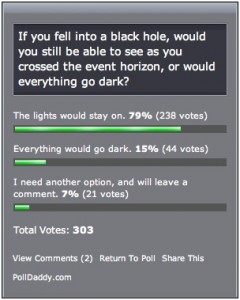 I ran a poll about a scientific issue on this blog a long time ago. Opinions are useful for telling you what people think... but the poll results have no bearing on the answer.
I ran a poll about a scientific issue on this blog a long time ago. Opinions are useful for telling you what people think... but the poll results have no bearing on the answer.
From Denier (1 of 3) on global warming: "You should hold open the possibility that if you think one thing and the world thinks something else that it might not be the world that is wrong. It might be you who is deluding themselves."
Surely you are not proposing that we now begin answering scientific questions through polling? There is a difference between "holding open the possibility" in the absence of evidence and "holding open the possibility" in the face of overwhelming evidence. The amount is how open I'll hold the door, as it should be for us all.
At an average warming rate of 0.07º C per decade, the Earth's temperature has not only increased, but continues to increase without any relief in sight. Image credit: NOAA National Centers for Environmental information, Climate at a Glance: Global Time Series, published January 2017, retrieved on January 18, 2017 from http://www.ncdc.noaa.gov/cag/.
From Denier (2 of 3) on the future of CO2: "Seeing as global CO2 emissions are currently flat, population growth is slowing and is set to reverse into population decline, technological advancement is still humming along, and every historical example shows roughly the same peak and decline curve, what do you think the future holds for global CO2 emissions?"
Global CO2 emissions are relatively flat. Population growth is more-or-less at an inflection point, set to plateau at around 11 billion at around the year 2100 (with some models predicting a slow decline afterwards and others not), and the large-population places where economic growth is occurring the most rapidly (e.g., China and India) are also seeing the greatest increase in per-capita CO2 emissions, in the face of technological advancement, I see global CO2 emissions remaining relatively constant, plus or minus maybe 20%, for the rest of the century so long as the current policies remain in place. Of course, that's constant with respect to the last few years of CO2 emissions, which are the highest rates in history. Let's take a look at the CO2 data!
 Image credit: Volker Quaschning, via https://www.volker-quaschning.de/datserv/CO2/index_e.php.
Image credit: Volker Quaschning, via https://www.volker-quaschning.de/datserv/CO2/index_e.php.
You can see we've roughly plateaued at a global annual emission from fossil fuels of about 32 Gigatonnes of CO2 per year. If that continues from the present until the year 2100, how many parts-per-million of the atmosphere will CO2 be? Current atmospheric CO2 is a little over 3,000 Gigatonnes, so we are talking about almost adding the same amount of CO2 to the atmosphere as is already there. But don't worry; the ocean absorbs a lot of the CO2, so we'll probably only be somewhere in the 600s as far as ppm goes by 2100. Again, that's my quantitative estimate, but that's probably too conservative according to most climate scientists. What do you think?
And from Denier (3 of 3) on climate models: "While it may be true that you can cherry-pick specific models that are within error bars between cherry-picked years, I can more easily point to models that are not.
http://www.drroyspencer.com/wp-content/uploads/CMIP5-73-models-vs-obs-20N-20S-MT-5-yr-means1.png"
You are not pointing to models that aren't within the data for cherry-picked years. You are pointing to bad data, plotted against successful models by someone who does not accept the very first point you agreed to, over and over, when you wrote this:
Question #1 – Is the Earth’s climate becoming warmer via a process that we can have influence on?
[...]
Alarmists answer the first question as ‘yes’. They answer it over, and over, and over with a ‘yes’. An avalanche of ‘yes’ is brought to bear on question #1.
Here is what the actual good data, from the actual satellites, shows:
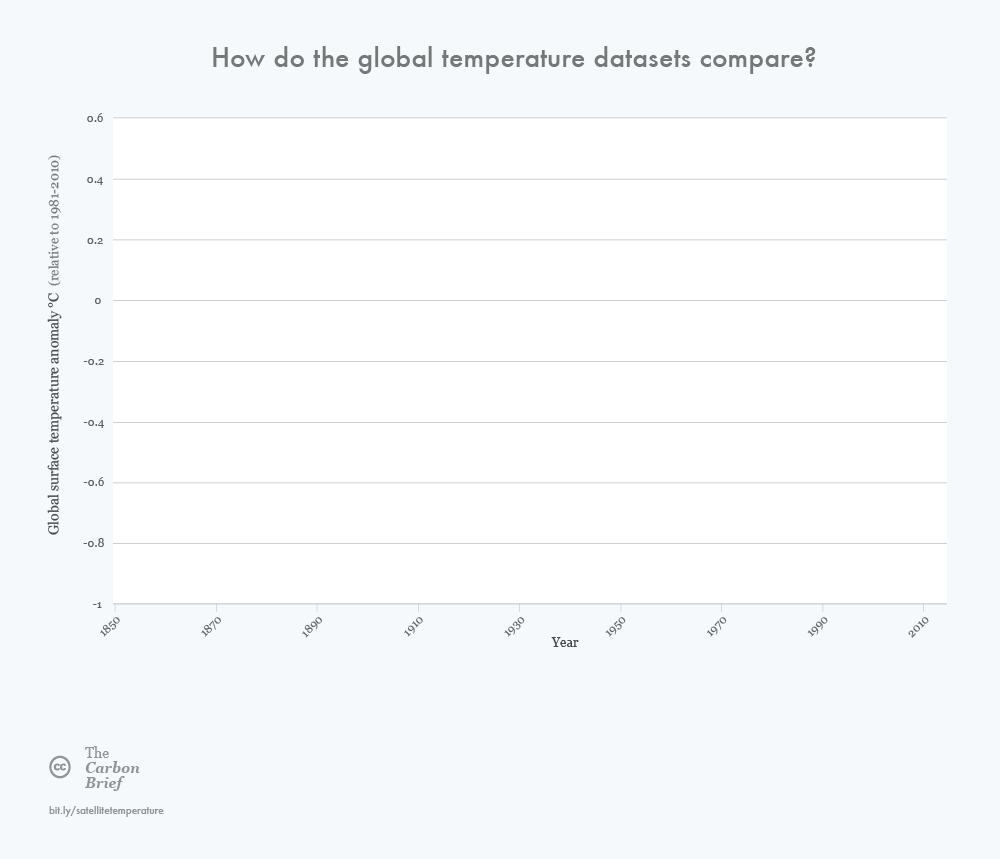 This is what the calibrated satellite data (RSS and UAH) looks like, along with surface data. Image credit: Rosamund Pearce, Carbon Brief.
This is what the calibrated satellite data (RSS and UAH) looks like, along with surface data. Image credit: Rosamund Pearce, Carbon Brief.
I assume you will not make that same mistake again, and that you will be pleased to learn what the actual data says, just as you should be pleased that we got a visit from an actual climate scientist in the comments, who said:
First, current estimates of warming are well within the error bounds of 1980s predictions, even considering the rather rudimentary tools available to make those estimates at that time (see jonathon’s post (#15) for a spot-on rebuttal of your post). Remember, also, that those forecasts from the 1980s were made under the assumption that no transient or unforeseen things would happen in the system. Such things have happened, and some of them have effected the earth’s energy budget in ways that counteract some of the warming. Despite this, the forecasts are still within those error bounds. Second, there’s more to the AGW hypothesis than just temperature increases. A whole suite of changes to the global system are predicted, some of which can really only happen if enhanced greenhouse content is the reason for current temperature increases. Probably the most telling of these (and the one that seems to get discussed the least, among the denier community) are changes in the structure of upper atmospheric temperatures, which are a clear fingerprint of and enhanced greenhouse world.
The whole point that I'm trying to make is we must agree on the same facts as a starting point if we want to have a real discussion about climate policy. If you don't want to have that discussion, or you want to exclude facts from that discussion, or you want to exclude voices from that discussion, then own it. But don't pretend that made-up facts get to be on the same footing in an argument with factual facts.
The Earth, moving in its orbit around the Sun and spinning on its axis, should provide an extra motion if there's any medium that light travels through. Image credit: Larry McNish, RASC Calgary.
From Carl on the Earth and the Sun: "From the post, “it would take 10^150 years for Earth to spiral into the Sun”.
With calculations this extreme, I wonder if the effects of expanding space (dark energy, “pushing” the Earth away from the Sun) were included. And if so, how do they compare in magnitude?"
This is a fun thing to consider, and a good thing to wonder about. Unfortunately, it doesn't work because the effects of dark energy are a global effect, but they do not occur within a bound system. If you waited an arbitrarily long time, the expanding Universe would not affect the size of the local group (but gravity would), the Solar System (but gravity would), the size of an atom (but electromagnetism would) or anything else that's already bound by a stronger force. Only if the Earth were gravitationally unbound from the Sun would dark energy play a role. It isn't, and so it doesn't.
From Michael Kelsey on the difference between a pulsar and a magnetar: "Pulsars and magnetars are both neutron stars with magnetic fields. Pulsar fields are typically a few megateslas (MT), and produce (due to their rotation) repeating signals in radio and microwaves, from the cyclotron motion of electrons around the field lines. Millisecond pulsars have even weaker magnetic fields, just tens of kT (the mechanism thought to spin them up to such high rotation rates would also reduce their initial pulsar-like magnetic field).
Magnetars have much, much stronger magnetic fields, of the order of GT. They produce periodic x-ray and gamma ray signals, likely from sychrotron radiation."
The big question that's still being worked on in this field is why most neutron stars become pulsars (and most don't "pulse" at us), but some become magnetars. Obviously, magnetars -- with higher magnetic fields by a factor of 1,000 or more -- produce radiation of higher energies, but why? There are pulsars that rotate faster, after all. The key seems to be temperature, which likely comes from the mass of the progenitor star and, hence, the mass of the neutron star. But this is something where we haven't had the key, deciding observations come in. We have good theories and models, but not the confirmation we'd seek; we need better observatories for that.
An accurate size/color comparison of a white dwarf (L), Earth reflecting our Sun's light (middle), and a black dwarf (R). Image credit: BBC / GCSE (L) / SunflowerCosmos (R).
And finally from John on black dwarfs: "Stars going dark in “only” around 1,000 times or “only” a million times the age of the Universe! Astronomical numbers again!"
The first white dwarfs to go "dark" will probably do so in about 2,000 times the present age of the Universe, when they will be "cool" enough that they no longer emit visible light. Given our Universe's current age, that's roughly when the Universe will be 30 trillion years old. In order to cool enough that they're only a few degrees above absolute zero, that's more like 100-1000 trillion years, depending on the model of cooling used.
But yes, no matter how you slice it, it is an astronomical undertaking! Thanks for an interesting week, and see you back here for more stories about the Universe soon!

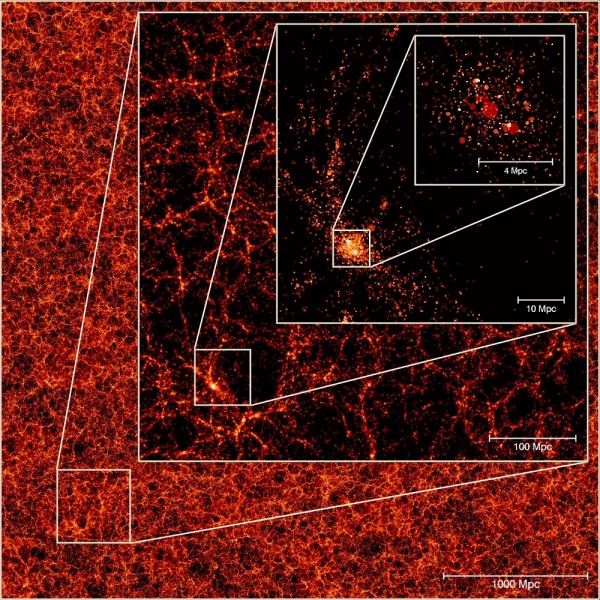
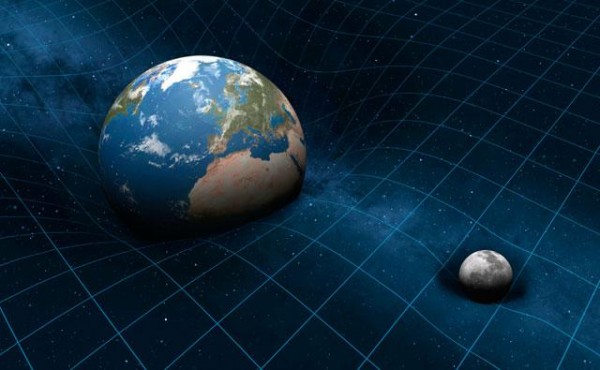


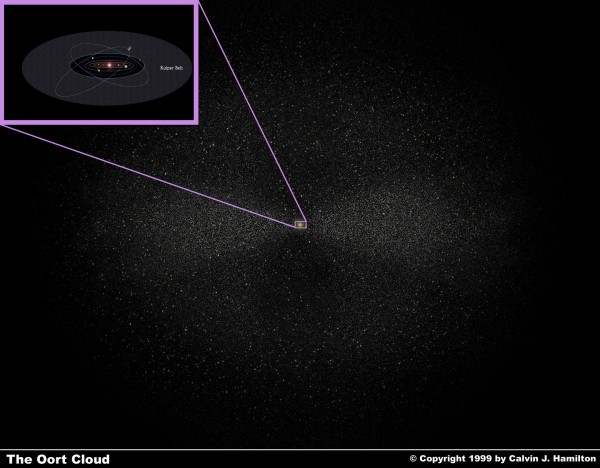
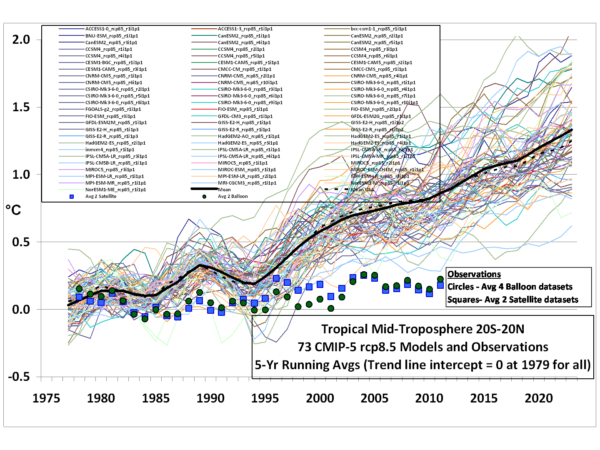

@Ethan
Of course not! In fact the comment had nothing to do with the science. You were whining about political action not reflecting scientific knowledge and that scientists should become political activists to address that. My comment was that perhaps the political action taking place is the correct action given *ALL* of the available knowledge (economic, societal, and physical science). I'm saying that if you think the political action is wrong then perhaps it is you operating on a shortage of knowledge (economic and societal).
I absolutely do think we should determine our collective political action via polling, and I oppose you every time you veer off into authoritarianism. I also said that you tend to drag responses back to science and one again you did not disappoint.
@Ethan wrote:
You mean when we're all ruled by unicorns and all social injustices will be solved? My comment was directed at the absurdity of using level or accelerating CO2 emissions in your back-of-the-napkin simulation over the next 283 years. In response, you've just done the same thing again but shortened it to 83 years. This part of your input is wrong. The high number you are getting is a product of garbage-in / garbage-out.
If you are trying to convey that atmospheric CO2 ppm is going to continue to climb, I'll give you that. It is. However it is a problem that is solving itself for all the reasons I laid out which you apparently couldn't find issue with.
@Ethan wrote:
What is it with you and attacking the source as a proxy for discrediting arguments lately? Not only that, but you are completely wrong.
Dr. Roy Spencer *DOES* believe the Earth's climate is getting warmer. The particular label he's been slapped with is a 'lukewarmer'. In his own words:
The cherry on top is that after you malign the man, you turn right around and use his dataset. Dr. Roy Spencer is in charge of the UAH dataset.
@Ethan wrote:
I think you are projecting. It wasn't me who wanted the Federal Government to "regulate" free speech on this subject. That was you.
I'm very happy to have all sides bring information to the table. When Doug the Climate Scientist chimed in, I thanked him for being there. I certainly didn't personally attack the man the way you just did Dr. Roy Spencer.
Ideas don't scare me, even dumb ones.
Ethan, you wrote this about elliptical galaxies and spiral ones: "The inner regions of spirals and ellipticals are comparable in densities, but the outer regions are where ellipticals are significantly richer in stars." Surely this would mean that ellipticals are *more* dense than spirals. But don't the numbers in fact show the opposite (at least for the monster elliptical you mentioned, where it would seem to be 10,000 times less dense than the milky way unless my calculations are way off)?
"But simulations are only a tool in the toolkit; there is nothing fundamental or special about them over any other theoretical tool."
Sure it's 'only a tool' just like Newton's laws or GR, but if one day we would come up with one new law/force out of which all the other forces would be emerging than that would be a pièce unique. And this is something that can only be done by experimenting with simulations.
We can simulate foams, liquids, gasses that generate patterns based on basic interaction … what other medium can we get out of it where light could be a wave and a particle? This kind of research/math can open a door beyond the curren 'dust collecting' experiments that are now trying very hard to pave the way towards new physics with hardly any really interesting results.
First to Ethan's slanderous comment that I have a history of spamming. I have been a serious critic of relativity for many years and have been banned from several science forums for the same kind of criticism of it I have posted here. That is not spamming. It is honest disagreement with bullshit like a flat Earth being an "equally valid" description or physical trains shrinking because "observer A" doesn't agree with "observer B" in a thought experiment... or like the distances between stars shrinking because an accelerated fast moving clock "keeps time" at a slower rate (and the Lorentz transform says so... "absolutely.")
But mainstream relativity tolerates absolutely no disagreement because its laws are considered to be absolute truth.
Now to review Ethan contradicting himself on length contraction. He still refuses to address it.
In comments from week 152 Ethan wrote the following:
-------------------------------------------
"From Michael Mooney on traveling close to the speed of light: “Does special relativity actually claim that distance, between stars for instance, depends on the speed of a traveler between them… not just “apparent” distance, but actual astronomical distance?”
(Ethan):
“It depends on the distance and to whom. If you’re in the spacecraft and moving towards a star 4 light years away, but you’re doing it at 88% the speed of light, then yes: the star will be only 2 light years from you, and you will reach it in a little over two and a quarter years. That contraction is “real”. Now your spaceship, to an outside observer, will also appear contracted, as the ball in the above image appears. Is that contraction physically real? We don’t think so. Relativity is still challenging to wrap your head around, even more than 100 years after we’ve first discovered it.”
He said that the first contraction is real. So the distance between stars varies with the speed of the traveler! (In violation of the science of astronomy.)
Is the contraction of the spaceship... or the ball in his example real? Some vague consensus of "we" doesn't think so. So that contraction is only apparent.
But, of course it's " still challenging to wrap your head around, even after more than 100 years." (Because it's bullshit and no reasonable person would believe it.) But relativity doesn't claim to be reasonable. It all depends on different observers seeing things differently.
Then he contradicted the above "we don't think so" as follows:
"" Does Earth physically change dimensions when viewed near the speed of light? The answer is yes, dependent on which observer you ask.”
It "physically changes"... depending on ... subjective differences. (Irrational contradiction in the same sentence!)
So now the spaceship and the ball don't contract (as above) but Earth does, depending on whom you ask, of course. (No real, objective, as is Earth. Not "real" science.)
“But the thing you want to be invariant — the physical size of a physical object — simply isn’t, nor is it well-defined in the absence of an observer.”...
The "reason" given by SR is simply the unquestionable dictum: "Length is not invariant." (It depends on how you look at it.)
” Are you claiming that physical objects aren’t really contracted in their direction of motion? They absolutely are…”
What happened to the spaceship and the ball that didn't really contract? Now they do? A change of opinion after catching up on mainstream length contraction in Wikipedia?
" If you see a contradiction, you are missing the point of what I am doing here."
What you are doing above is contradicting yourself.
" Physics concerns ourselves with this Universe. Your philosophical criticisms have no physical foundation,"
Even the word physics is based on investigation of the physical universe. Yet no relativity theorist will ever explain the physics of shrinking physical objects, because there is no "physical foundation" for it!
I am curious about the dark star's properties when it finally cools down. Assuming no further accretion, it's mass and size should be roughly the same order of magnitude as it is currently (im unsure how much mass it would lose through its EM radiation from now until it cools). Once the plasma cools and stops emitting light, would there be a (solid?) mass left over with similar neutron-star level density? the gravity would still be enough to crush anything on the surface, so what would the leftover mass look like?
@MM
" It is honest disagreement with bullshit"
- the only bullshit here is you.
"But mainstream relativity tolerates absolutely no disagreement"
- there is no such thing as mainstream relativity except in that misguided head of yours. Physics is founded on criticism and investigation and experiment, you ox! You are NOT making any scientific critique about anything, let alone GR or SR, since you know jackshit about science, or physics or anything that you are posting.
"because its laws are considered to be absolute truth."
- ROFL!.. no Looney Mooney... it's because they're based on experimental evidence, repeatable by anyone who has a will to try. Only religious zealots and crackpots like you are shouting strawman, but at the end of the say you're just too lazy to actually study anything. Pathetic!
@MM
Have you ever seen those curvy mirrors that make real objects fat or thin? Well in a similar way our measurements are distorted when we travel fast or slow.
I hope you are now somewhat getting what these professional scientists are talking about, becuase I feel sad for you not getting now already for years, what most of us start to understand after a few hours of studying.
Ethan as usual has it ass backwards with the usual left hand waving exercise in scientism propaganda.
How can he honestly claim that temperature readings taken from actual measurements from balloon and satellites are 'bad data' in comparison to utter 'non data' forcasts generated by computer models based on....theory?
Yeah, right.
We wouldn't want to let those pesky empirical observations get in the way of a really popular political theory now would we. Move over Lysenko, Siegel is here!
This is another formal complaint.
@Sinisa Lazarek, # 9:
In particular,
"– the only bullshit here is you."
"... you ox!."
"– ROFL!.. no Looney Mooney"
"... crackpots like you..."
Etc., etc.... " you’re just too lazy to actually study anything. Pathetic!"
Your own recent rule forbids that shit. Was that just talk too?
I do understand that you are not replying to me anymore... You've been so patient! with your lectures on the Truth of Relativity... but this is for those who care.
MM:
It's spamming when you bring up the same subject in every thread, including ones that have nothing to do with it. If you were in a room with someone, it would definitely be considered rude and possibly harassment - to follow someone around a room, and every time they try and start a conversation about something else, you demand they answer the question you brought up several conversations ago. One definition I found defined it (in part) as "he act if obnoxiously doing something repeatedly for attention." You certainly doing something repeatedly, and demanding Ethan's attention.
No, as Sinisa, said, the reason scientists accept SR is because empirically it works; it is an observationally accurate description of what happens at high relative velocity. And as far as I can tell, you have never suggested an experiment or an observation that we could do to show when and where it's inaccurate.
@Elle H.C. #10
Thank you for confirming that the apparent shrinking of physical objects and distances is all illusion. Yet these distorted images are only hypothetical/ theoretical. No one has ever seen Earth, a train, a ladder, etc traveling at near light speed (the object or the traveler... same, speed being relative to whatever.
"These professional scientists", however are professing that physical objects do in fact shrink, because all measurements (including theoretical) are said to be equally valid.
When you " start to understand after a few hours of studying" that a flat Earth (physically speaking) is equally valid with a spherical Earth then you are "getting it"... as per completely brainwashed by SR nonsense.
Please don't pity me for pointing out what bullshit that is.
Eric,
You misunderstand my intention, which is to point out the fallacies in assuming that all measurements from all frames of reference are equally valid descriptions of the physical world and that "space-time" is not an actual entity like a malleable fabric... or a landscape through which one can "time travel."
You once said that you too reject physically shrinking objects. Yet that is what Ethan and mainstream theorists insist upon as "absolutely" proven. Have you changed your mind to get in line with Ethan and all?
You've pointed out what you percieve as fallacies. On multiple threads. Over weeks. Most of those threads having nothing to do with the subject of relativity. Everyone gets it. Your intention is fulfilled; go in peace. Or at least limit yourself to discussing relativity on threads about relativity.
I have told you before; relativity is a difficult subject to parse in normal vernacular, but Ethan, I, and all other mainstream scientists use the same physics. We agree on the equations. That's the important description as far as I'm concerned. The words are there to help us understand the physics, but they are not the physics.
@Michael Mooney,
I wouldn't be too surprised by the disagreement about what is actually going on with SR, or GR either for that matter. If you ask thirty physicists what their take on it is, you will not get thirty consistent answers, and some of those answers are going to contradict one another. Physicists are more fond of saying they agree with Einstein, than actually understanding what they are agreeing with, as they are judged summarily by their peers about it like a political purity test. The same goes for explanations about QM or QED, both of which are more arguments from authority 'interpretations', (admittedly so) than actual empirical understanding of process. Sean Carroll (someone I don't agree with about much) even acknowledged this 'interpretation' problem on his own site:
.
http://www.preposterousuniverse.com/blog/2013/01/17/the-most-embarrassi…
@MM,
"Thank you for confirming that the apparent shrinking of physical objects and distances is all illusion.
Scientists are professing that physical objects do in fact shrink"
Finally we can all agree that real object can optically shrink.
CFT,
If you "ask Ethan" what his take on relativity is (again), he will give us one answer in one "Weekly Comments" post and another answer in another post a few weeks later.
I gave an example of that in tedious detail... repeated after his standard dodging of the direct challenge and his slander of me personally... to avoid responsibility for addressing his obvious contradictions.
Attack the critic; avoid the argument. Praise Einstein and the whole gang of followers of the 'It depends on how you look at it" philosophical belief... now called "science.
(Neo- Idealism applied as RELATIVITY.... the "science" of different observational perspectives... each with its own subjective "reality." It's now The Law.'
The argument is closed.
Elle H.C.:
"Finally we can all agree that real object can optically shrink."
Sorry. The Law of Length Contraction states that real objects physically shrink. (Not just "optically.")
Study up.
"Attack the critic"
You didn't spell "tiresome kook" correctly.
Well done, dean. Another personal insult... this time veiled as something I said... but didn't.
Very sly. Not worthy of scientific discussion, but very foxy! No insult there!
Ethan needs all the help he can get from his true believer back-up squad. After his example, shame the critics into going away! Avoid the non-existent physics of shrinking objects.
(The usual "mainstream" strategy.) Again, I'm not intimidated.
The Observers create their own individual "realities"... and (what do you know!)... they don't agree! No objective world.
They must all be right... because... "all frames are equally valid." That is the law, proven beyond all doubt... so y'all seem to believe.
This is pretty ironic, coming as it does from a Cosmic Minder.
And the Higgs field explains both gravity and ESP.
"Ask him what he means by 'paranormal.'
"His reply will show that he is assuming an ontological mind-matter dualism and that he is assuming that any evidence of what he calls 'precognitive,' or 'ESP' experience demonstrates the hypothesis that mind is greater than matter, or more 'powerful', and that it is the acceptance of this hypothesis that is a 'step along the way.' Further (if you keep pushing him) you will discover that what impresses him about this kind of behavior on the part of 'mind' is that it acts like matter, in that it 'pushes things around' or 'flows' or 'reaches out' [emphasis added] rather than 'merely' thinking or perceiving. In this, he sees hope that his mind or personality will escape death and 'transcend' matter. This is the 'Buddhism' of such as Evans-Wentz.
"It is 'metaphysics' as physical reductionism, a way of turning the mind into a variety of matter that is (he hopes) 'powerful' enough to survive."
(When you attack an occultist’s theories, he will usually respond by defending the possibility that certain events have occurred. Never question the events, even though they are frequently questionable. Admit at once that anything may happen, and insist that it is his reasoning, not his facts, which you find objectionable.)
^ Ah, well, failed to close the URL after the end of the first graf. Sorry about that.
OK, so just to wrap up my thoughts this evening about Mr. Mooney, who seems to in fact be some sort of version of Deepak Chopra turned inside-out,* I think that I would be remiss in failing to mention a crank who at least put(s) some effort into things,** to the point that his Usenet efforts merited a very nice musical homage, George Hammond (Interröbang Cartel, Needs More Wanger).
* This ontological 'stuff' must be sturdy indeed, given that the inversion of its pajamas shows little sign of wearing the fabric; flexible seams are par for the course.
** Currently ht[]p://independent.academia.edu/GeorgeHammond.
@MM,
"The Law of Length Contraction states that real objects physically shrink. (Not just “optically.”)"
No, it is about measuring:
"Length contraction is the phenomenon of a decrease in length of an object as measured by an observer"
https://en.wikipedia.org/wiki/Length_contraction
@ Narad
interesting find :D No wonder MM and Kasim hit it off instantly. Both are self-proclaimed occultist who lost their marbles along the way.
I think they dwell here cause more people (sadly) read what they wrote here then on their own websites.
So... Still no physics of shrinking objects.
Just more physics of how different observers see things differently. (No doubt they do.) And they are all correct, so they say, because there is no objective world independent of all varieties of differences in measurements. (Idealism, not objective science.)
...And of course more personal attacks, the mainstay of this site and of the mainstream to dismiss all criticism.
I have never mentioned my website or mystic (not "occult") worldview, because it is not (yet) science, and this is supposed to be a science site.
When and if the physics of the Higgs Field is understood to be omnipresent, it may well bring science (gravity, for instance) and paranormal phenomena into a "unified field."
Until then, it ain't science yet.
MM, if you have an issue with a theory in science the way to support your case is not as you've been doing -- simply jumping up and down and screaming "That isn't right" -- you need to demonstrate why your point is correct by showing data supporting your side or demonstrating (not asserting, demonstrating) where the theory goes wrong. You haven't done that. (You have that in common with the other cranks cft and denier, so you aren't alone there).
If you don't want to be referred to as a crank don't behave as a crank.
If anyone here is idealist, then it's you. You're the obsessing about your own mental constructs, and can't seem to comprehend that NO ONE HERE CARES about what you believe! Science, and physics in particular doesn't deal with immaterial.
Then again, why am I not surprised that you don't even know the definition of idealism.
"I have never mentioned my ... mystic (not “occult”) worldview,"
oh really.. and what exactly is the difference between the two MM? (mystic v. occult)
So... Still no physics of shrinking objects.
Observational differences are thoroughly covered by SR. No argument there.
With respect to this site as an *intended* (but failing) discussion of science... not a personal brawl... I will not debate or defend my website here.
Whether or not there is a Higgs field, omnipresent, connecting all " things"... no "spooky action at a distance..." and all "dimensions," including the forbidden topic, "consciousness," ... is still theoretical, not empirical science... until the theory is verified... or not.
All you flat Earth SR true believers are totally brainwashed beyond all reason and lacking actual empirical evidence. Thought experiments do not qualify as "knowledge," in formal epistemology.
Not that you true believers care about how we know what we claim to know. It's all right there in the text books. Who are we amateurs to question such established authority?
....The non- indoctrinated free thinking critics. We are probably in the majority, as I see see it on the World Wide Web. But you can't get a doctorate in physics if you try to think for yourself.
First rule: Never disagree with Einstein. He sure got E=MC squared right!
I thought this briefly, but it's giving Mr. Mooney too much credit. Monist idealism at least can be coherent, until it runs into the association of ideas and other steamer trunks full of ontological baggage.
Mooney is simply a philosophical primitivist with a free-wheeling approach to the externality of relations and a Euclidean metric determined to get out from his trousers and onto the village green. He is the preferred frame of reference.
@MM
"The non- indoctrinated free thinking critics."
When it comes to physics you can't just do some 'free thinking'. There are rules that make up the physical world.
@MM
I really find it hard to believe that you are really that ignorant. Ok, so you don't know science or physics.. ok.. not everyone does. But you don't seem to know anything really.. not philosophy, not metaphysics, not mysticism... As your new president says... "Sad!"
"All you flat Earth SR true believers are totally brainwashed beyond all reason and lacking actual empirical evidence. "
This sentence.. and all your inner anger about all of this is manifest in this sentence. Any physicist regardless of the field will laugh on this. And here's why.. We DON'T BELIEVE in ANYTHING! We USE something as long as it viable. And by viable meaning offering empirical data and prediction. As soon as something better or more precise comes along, we will use that, and won't sweat anything about relativity. We KNOW the limits of our theories (unlike you). Even today, we know that GR will be updated with something newer, because there are question e have that GR doesn't give answers to. But that won't mean SR/GR is wrong, just like newton isn't wrong.. but things progress and things improve.
Funny how your're projecting yourself and your own flaws into all this. You are the one WHO HAS TO BELIEVE in supernatural in order for your IDEALISM to work... not us.
So again... no.. as much as you would like it to be so... physics doesn't deal with faith, beliefs, ideals, contemplations, meditations, levitations, astral projections, nor crazy deranged religious zealots like yourself.
@SL
https://pbs.twimg.com/media/BYosq5ZCEAAgCGZ.jpg
LOLs ... haven't seen that one before :D
All that bluster but still no physics of shrinking objects.
We can all assume that observer A traveling near light speed relative to an object will see it differently than observer B at rest with the object.
But the gospel of length contraction according to SR insists that the object IS, say, half the length that B sees it and that the shrunken object is "equally valid"... even to the ridiculous absurdity of a flat Planet Earth.
Is anyone here irrational (crazy) enough to try to make an actual case for the flat Earth version as equally valid... knowing what we know (it's called epistemology) about Earth and EXPLAIN THE PHYSICS OF SHRINKING PHYSICAL OBJECTS?
Or are just more personal attacks all you've got?
One more time:
That A might see/measure it as contracted in the direction of his approach does not physically flatten the near spherical body of Planet Earth. The fallacy of all other "shrinking objects" then too is obvious.
Ethan: "Your philosophical criticisms have no
physical foundation, and until they do, I am happy to let the other commenters on this forum take it from here."
Philosophical? ALL epistemology... what we KNOW about Earth in this case... confirms that it is nearly spherical. There is NO FOUNDATION for the claim that a flat Earth is "equally valid," just because SR says that Earth (and the cosmos in general) changes from one observer to another... all "reality" depending on which one you ask.
If there is any scientific integrity in this forum, there must be an answer to the "physical foundation" of shrinking physical objects. "For observer A vs for observer B" is always about theoretical perceptual differences, not actual shrinking objects. Ethan now claims, having changed his mind to comply with standard SR, that physical objects actually do shrink, not just apparent phenomena. I've quoted him several times on his contradiction/ change of mind.
Do any "other commenters" care to address this issue, or must this most basic criticism of SR continue to be swept under the rug, as Ethan has done above?.
Last call. Is there an honest scientist in the house?
I've got some bad news for you.